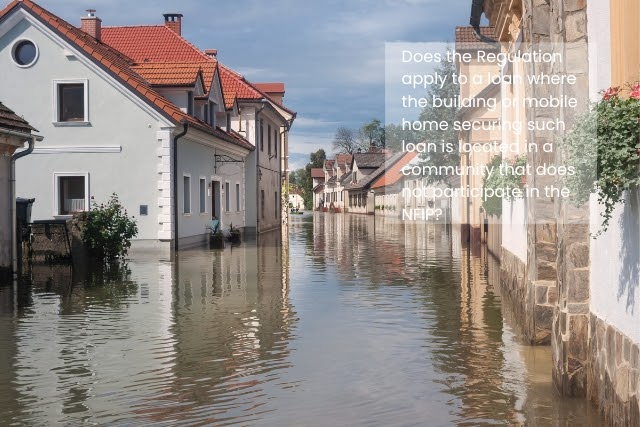Introduction:
In today’s discussion, we delve into a pertinent question surrounding financial regulations and property ownership: “Does the Regulation apply to a loan where the building or mobile home securing such loan is located in a community that does not participate in the NFIP?” The National Flood Insurance Program (NFIP) plays a pivotal role in safeguarding properties from flood-related risks in the United States. However, the applicability of regulatory measures to loans secured by properties situated in communities not participating in the NFIP raises intriguing complexities.
This inquiry prompts a closer examination of the intersection between federal regulations, property ownership, and disaster resilience. We will explore the implications for lenders, borrowers, and the broader financial landscape, shedding light on the challenges and considerations that arise when dealing with properties outside the NFIP’s protective umbrella. Join us as we navigate this critical aspect of property financing and flood risk management.
- Introduction to NFIP and Regulatory Concerns
- NFIP Participation Impact on Loan Regulations
- Federal Regulations and Non-Participating Communities
- Lender Obligations and Risk Assessment
- Borrower Considerations and Insurance Options
- Policy Recommendations for Non-NFIP Communities
Introduction to NFIP and Regulatory Concerns:
The National Flood Insurance Program (NFIP) is a critical federal initiative aimed at reducing the financial burden of flood-related damages in communities across the United States. It provides flood insurance to property owners, thereby mitigating the risks associated with flooding. However, the question of whether federal regulations apply to loans secured by properties in communities that do not participate in the NFIP raises complex regulatory concerns.
This introduction sets the stage for a deeper exploration of how NFIP participation, or lack thereof, can impact loan regulations. It highlights the significance of the NFIP in managing flood risk and introduces the central query regarding regulatory applicability in non-participating communities.
It provides flood insurance coverage to those residing in participating communities. The introduction to this topic serves as a foundation for understanding the critical role of NFIP in flood risk management. It highlights the regulatory concerns that arise when properties securing loans are situated in communities that do not participate in the NFIP.
NFIP Participation Impact on Loan Regulations:
NFIP participation status plays a pivotal role in determining the regulatory framework for loans secured by properties in flood-prone areas. Communities that actively participate in the NFIP are subject to a set of federal regulations designed to ensure flood insurance coverage. However, in non-participating communities, the situation becomes more intricate.
Lenders and borrowers face a different set of challenges when dealing with properties in such areas, where federal regulations may not apply in the same manner as they do in NFIP-compliant regions. This section delves into the specific impacts of NFIP participation on loan regulations and the corresponding implications for the stakeholders involved.
NFIP participation has a profound impact on the regulations governing loans for properties in flood-prone areas. In participating communities, lenders are obligated to ensure that borrowers maintain flood insurance coverage on their properties, in compliance with federal law. However, when dealing with properties in non-participating NFIP communities, lenders often face a different set of rules and challenges. This section examines how NFIP participation status affects loan regulations, emphasizing the disparities between participating and non-participating communities.
Federal Regulations and Non-Participating Communities:
The absence of NFIP participation in certain communities necessitates a closer examination of federal regulations governing flood risk. In non-participating areas, lenders and borrowers may not be bound by the same level of federal oversight and may have more discretion in managing flood insurance requirements.
This section explores the intricacies of federal regulations in non-participating communities, shedding light on the potential gaps, challenges, and flexibility that may exist in the regulatory landscape. It also considers the broader implications for disaster resilience and risk management in such areas.
When properties securing loans are located in communities that do not participate in the NFIP, federal regulations related to flood insurance may not apply in the same manner as they do in participating communities. This section delves into the complexities of federal regulations in non-participating communities. It explores the potential gaps and differences in regulatory oversight, highlighting how this unique scenario can impact both lenders and borrowers.
Lender Obligations and Risk Assessment:
Lenders play a critical role in assessing and managing risk when offering loans secured by properties in flood-prone regions. However, the nature of their obligations can vary depending on whether the property is located in an NFIP-participating community or not.
Here, we delve into the responsibilities and risk assessment practices that lenders must adopt when dealing with properties in non-NFIP communities. This includes evaluating the need for flood insurance, determining appropriate coverage levels, and ensuring compliance with applicable regulations.
In NFIP-compliant areas, lenders are guided by clear federal regulations that outline their obligations in terms of flood insurance requirements. However, in non-participating NFIP communities, lenders may have to rely on different risk assessment practices. This section examines the specific obligations lenders face and how they must adapt their risk assessment strategies when dealing with properties in non-NFIP communities.
Borrower Considerations and Insurance Options:
For borrowers, securing a loan for a property in a non-participating NFIP community may involve different considerations than in NFIP-compliant areas. Understanding the available insurance options and their implications is crucial for informed decision-making.
In this section, we examine the factors borrowers should take into account when obtaining loans for properties in such communities. It explores the potential challenges in securing flood insurance and offers guidance on navigating the complexities of insurance choices. Unlike borrowers in participating areas who are subject to federal mandates, those in non-participating communities may have to navigate a more complex landscape of insurance options. This section explores the considerations borrowers should keep in mind when securing loans for properties in such regions. It also provides insights into the challenges and choices they may encounter when seeking flood insurance coverage.
Policy Recommendations for Non-NFIP Communities:
As we conclude our exploration of the topic, we turn our attention to potential policy recommendations that can enhance disaster resilience and risk management in non-NFIP communities. Given the unique challenges posed by these areas, it is essential to consider measures that strike a balance between protecting property owners and promoting community participation in flood risk mitigation efforts.
This section offers insights into policy solutions that may bridge the regulatory gaps and encourage NFIP participation in more communities. It outlines strategies to improve flood insurance affordability, increase awareness, and incentivize participation to better protect both lenders and borrowers in these vulnerable areas.
Conclusion:
I hope that this discussion has shed light on the complex interplay between regulations, the National Flood Insurance Program (NFIP), and loans secured by properties in non-participating NFIP communities. Our exploration has revealed that the regulatory landscape for such loans is nuanced, with implications for lenders, borrowers, and policymakers.
In conclusion, the absence of NFIP participation in a community can significantly affect the regulatory framework surrounding loans for properties located in flood-prone areas. Lenders face unique challenges in assessing and managing risk, while borrowers must navigate insurance options that may differ from those in NFIP-compliant regions.
To address these challenges, policymakers should consider proactive measures to incentivize NFIP participation in more communities, thereby enhancing disaster resilience. These measures may include improving affordability, raising awareness, and providing incentives for compliance. By taking such steps, we can better protect both lenders and borrowers in non-NFIP communities, ultimately reducing the financial impact of flood-related disasters.

